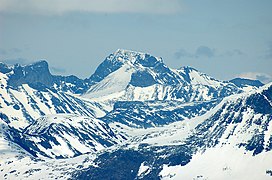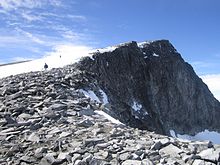| This article needs additional citations for verification. Please help improve this article by adding citations to reliable sources. Unsourced material may be challenged and removed. Find sources: "Galdhøpiggen" – news · newspapers · books · scholar · JSTOR (November 2024) (Learn how and when to remove this message) |
| Galdhøpiggen | |
|---|---|
 Galdhøpiggen viewed from the west (Fannaråki) Galdhøpiggen viewed from the west (Fannaråki) | |
| Highest point | |
| Elevation | 2,469 m (8,100 ft) |
| Prominence | 2,436 m (7,992 ft) |
| Isolation | 1,567.4 km (973.9 mi) |
| Listing | Country high point Ultra |
| Coordinates | 61°38′11″N 8°18′45″E / 61.63644°N 8.31248°E / 61.63644; 8.31248 |
| Naming | |
| Pronunciation | [ˈɡɑ̀ɫhøːˌpɪɡn̩] |
| Geography | |
  | |
| Location | Innlandet, Norway |
| Parent range | Jotunheimen |
| Topo map | 1518 II Galdhøpiggen |
| Climbing | |
| First ascent | 1850 (Steinar Sulheim, S. Flaatten and L. Arnesen) |
| Easiest route | Hiking |
Galdhøpiggen (Norwegian pronunciation: [ˈɡɛiɫdɘːˌpɪɡn̩ or ˈɡɑ̀ɫdɘːˌpɪɡn̩]) is the highest mountain in Norway, Scandinavia, and Northern Europe. The 2,469-metre-tall (8,100 ft) mountain is located in Lom Municipality in Innlandet county, Norway. It is in the Jotunheimen mountains within Jotunheimen National Park. The mountain sits about 25 kilometres (16 mi) southwest of the village of Fossbergom and about 45 kilometres (28 mi) northeast of the village of Øvre Årdal. The mountain is surrounded by several other notable mountains including Keilhaus topp to the east; Store Styggehøe to the southeast; Svellnosbreahesten, Midtre Tverråtinden, and Store Tverråtinden to the south; Storjuvtinden and Skardstinden to the west; Veslpiggen, Storgrovtinden, and Storgrovhøe to the northwest; and Galdhøi and Juvvasshøi to the northeast.
Etymology
| This section does not cite any sources. Please help improve this section by adding citations to reliable sources. Unsourced material may be challenged and removed. (November 2024) (Learn how and when to remove this message) |
Galdhøpiggen means "the peak/spike (piggen) of the mountain Galdhø." The first element in the name of the mountain is gald (m.) which means "steep mountain road". The part of the valley Bøverdalen closest to the mountain is called Galde. The last element is hø (f.) which means "(big and) rounded mountain." An old road between Gudbrandsdalen and Sogn passes beneath the mountain.
History
| This section does not cite any sources. Please help improve this section by adding citations to reliable sources. Unsourced material may be challenged and removed. (November 2024) (Learn how and when to remove this message) |


Geologically, Galdhøpiggen belongs to the Caledonian folding, like most of South Norway's mountain ranges. The peak is made of gabbro, a hard but rather coarse-grained rock which is found in most of the Jotunheimen range. During the ice ages it was heavily glaciated and got its present form. The theory that the highest summits in Norway stayed above the ice as nunataks has been abandoned by most geologists. It fits well with the present flora in the area, but it does not fit well with the present knowledge of ice thickness and the results of glaciation.
For many years, geologists did not know that Galdhøpiggen was in fact the highest summit in Norway. That distinction was instead granted to Snøhetta in the Dovrefjell range, visible on the Oslo-Trondheim land route. Hence no attempts were made to climb the peak, while Snøhetta was visited for the first time in 1798 as part of a scientific trip to the area. In 1844 the geologist and mountaineer, Baltazar Mathias Keilhau, made two unsuccessful attempts to reach the summit. On one of these he reached a summit, which was later named Keilhaus topp (at 2,355 m above sea level very close to Galdhøpiggen), but the terrible weather forced him to return.
In 1850 three men from Lom reached the summit; the guide Steinar Sulheim, the local teacher Lars Arnesen and the church warden Ingebrigt Flotten.
Access and modern tourism
There are two possible routes to reach the summit. One starts at Juvasshytta and the other at Spiterstulen. There are three summits on the route from Spiterstulen: Svellnose, Keilhaus topp and the summit itself. During the main season guided trips take one to the summit from Spiterstulen via the well known blue ice fall on Svellnosbreen.
The main season for hiking to Galdhøpiggen is between June and August. The season is determined by the melting and first appearance of snow, so it does not follow a set date. The peak is a common destination for backcountry skiers in the months of April and May.
At Juvasshytta there is an alpine ski resort with lift on a glacier, reaching an elevation of 2,200 metres (7,200 ft) above sea level, the highest in Scandinavia. It is called Galdhøpiggen Summer Ski Centre and is open from June and all the summer when the road is open.
Summit
Galdhøpiggen had earlier been challenged for the title as the highest mountain in Norway by Glittertind, as some measurements showed Glittertind was slightly higher including the glacier at its peak.
This glacier has, however, shrunk in recent years, and Glittertind is now only 2,464 metres (8,084 ft) even including the glacier. Hence, the dispute has been settled in Galdhøpiggen's favour.
At the summit a small cabin has been built. In the summer soft drinks, chocolate bars, postcards and other items are sold here. Earlier the Norwegian Postal Authority had a small post office here—being the highest in Northern Europe. Galdhøpiggen is not only the highest summit in Northern Europe, it also contains two probably unbreakable horticultural records in Northern Europe, being the upper limit for Ranunculus glacialis (2370 m) and Saxifraga oppositifolia (2350 m). Since the summer might not occur at all, some years, it tells something about these flowers' adaptation to the extremely harsh climate.
On sunny days in the later part of July and August, the summit is visited by hundreds of people.
Media gallery
 The view from the top (scroll left/right to see the view)
The view from the top (scroll left/right to see the view)
See also
- List of mountains in Norway by height
- Extreme points of Norway
- List of mountain peaks by prominence
- List of European ultra-prominent peaks
- Scandinavian mountain range
References
- ^ "Galdhøpiggen". PeakVisor.com. Retrieved 8 May 2022.
- ^ "Europe Ultra Prominences". Peaklist.org. Retrieved 17 February 2013.
- "Top 100 Mountains in Scandinavia ranked by primary factor".
- "Galdhøpiggen, Lom" (in Norwegian). yr.no. Retrieved 8 May 2022.
- ^ "Galdhøpiggen Hiking Guide (Multiple Hiking Options + Tips) - The Norway Guide". 18 July 2022. Retrieved 19 August 2022.
- "Galdhøpiggen Summer Ski Centre". Archived from the original on 27 April 2009.
Sources
- Dyer, Anthony; Baddeley, John; Robertson, Ian H. (2006). Walks and Scrambles in Norway. Rockbuy Limited. ISBN 9781904466253.
- Pollmann, Bernhard (2000). Norway South: Rother Walking Guide. Bergverlag Rudolf Rother. ISBN 9783763348077.
External links
- [REDACTED] Media related to Galdhøpiggen at Wikimedia Commons
- Galdhøpiggen
- "Galdhøpiggen, Norway" on Peakbagger
- Galdhøpiggen
- Droner i naturen skaper reaksjoner: – Mange driter i at det er forbud (18 June 2021) NRK
- Juvasshytta (in Norwegian)
- Computer generated summit panoramas North Archived 8 October 2007 at the Wayback Machine South Archived 8 October 2007 at the Wayback Machine Index
| Ultra-prominent peaks of Europe | |
|---|---|
| Scandinavia & Arctic | |
| Western Europe |
|
| Atlantic islands |
|
| Alps (List) |
|
| Apennines | |
| Eastern Europe |
|
| Balkans | |
| Mediterranean islands | |
| Caucasus | |
Categories:

